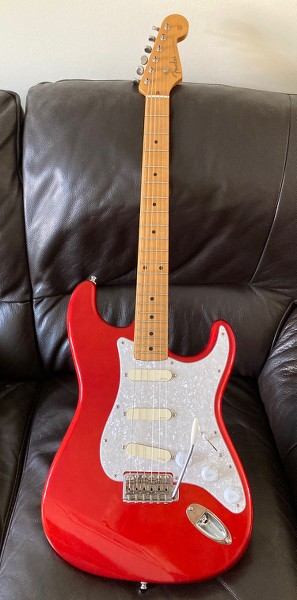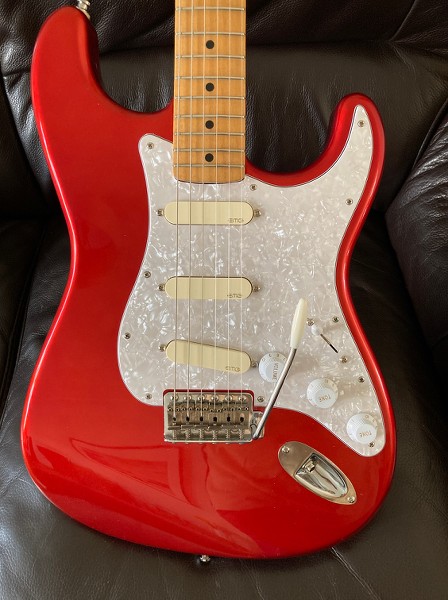Someone pointed out how much my Dave Gilmour Strat had gone up in value since Dave auctioned off his guitars and Fender had to stop making them. Some of them that have been left unused (a crying shame) can now go for £10k, whilst a played one like mine can go for £6k. Not a bad increase when it cost £2800 in early 2011.
But it got me back into playing it and putting together some Gilmour-style pedals, which then got me watching the concert videos and which then led to his red Strat and feeling my life was incomplete without one.
So I bought a 1996 Japanese 1950s-style Strat in Candy Apple Red and the EMG DG20 loaded scratchplate and simply put them together.
The Black Strat and pre-op red Strat together, along with the yet-to-be-fitted scratchplate:
And the post-op red Strat:
I had to fill and drill a few holes for the pickguard as the EMG scratchplate needed more screws. The neck got a levelling and fret profiling and the jack socket got a Pure Tone socket fitted. I also fitted a Hipshot Tremsetter (my own choice as I'd been impressed with the ones I'd fitted to a friend's guitar) and made a shortened trem arm.
It's got a chunky '54 D-shaped neck (according to the stamp on it), though I detect a touch of 'V' to it.
The EMGs are active pickups (3 of their SA model), so there's a battery hiding under the scratchplate. The controls are different to a standard Strat's Volume/Tone/Tone arrangement (despite the same knobs being used) and has a volume/EXG/SPC arrangement. The EXG is EMG's mid cut + treble and bass boost control, whilst the SPC is EMG's mid boost control.
My old white Chandler Custom Strat (a famous music shop in Kew, London, sadly now defunct) from the 80s had EMGs and had the SPC presence boost control, but I wish I'd had the EXG fitted as it brings the clean but rather flat sounding EMGs to life. With judicious use of the EXG and SPC controls, I can make the red Strat sound like the black Strat!









 Reply With Quote
Reply With Quote
